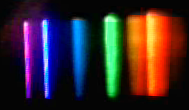Colour Flashes from light bulbs
Ingredients
A conventional light bulb acts as you would expect, when the power is removed, the filament cools down from white hot through orange, to red hot and eventually stops emitting in the visible region.
| |
| An incandescent light bulb turning off slowed down by a factor of 50. |
However when I pointed the camera at a compact fluorescent bulb, something more interesting happened.
| |
| An energy saving light bulb turning off slowed down by a factor of 50 |
It flashed green as it turned off. So I tried it on a fluorescent tube in the kitchen, as fluorescent tubes and energy saving light bulbs are essentially the same technology, so I thought there might be a similar effect.
| |
| A fluorescent tube turning of slowed down 50x |
To start off with you can see the 100Hz flashing caused by the 50Hz mains not producing a constant current in the tube. Then as the tube turns off it flashes yellow and for considerably longer than the energy saving light bulb.
Why?
 |
| Spectrum of an energy saving light bulb. Each line is produced by a different type of phosphor. |
I think what is going on is that a fluorescent light bulb works by passing a current through mercury vapour inside the tube. This glows in the ultra-violet region of the spectrum very efficiently but ultra-violet is invisible. So, the inside of the tube is covered with phosphors, each of these convert the ultraviolet into a particular colour of light.
If you look at the spectrum of an energy saving bulb you can see the colours produced by the each of the different phosphors.
Phosphors absorb energy and then remit it in the form of light. Different phosphors do this at different rates, and in the energy saving bulb they slowest is probably the green, so it keeps emitting for the longest once you have turned the bulb off. Hence the green flash.
The fluorescent tube obviously uses a different yellow phosphor which is also slow and so it produces a yellow flash. If this is the case then the yellow should be the last colour to turn on and the tube should turn on as a different colour.
I took advantage of the dodgy starter on the fluorescent tube in my garage to test this out.
| |
| A flashing fluorescent tube slowed down 50x |
And as you can see, as it turns on it first goes blue, which must be the fastest phosphor then goes white as the other phosphors catch up, and then as it turns off it goes yellow as before, which I think means that this explanation hangs together.










Comments
Add a comment